|
|
|
|
|
|
|
Achi-Kochi Japan
Showing many places to visit and foods to eat in Japan
|
|
|
|
|
|
|
|
|
|
|
|
|
Japan
> Themes
> History vol.1 Formation of Japan
|
|
|
|
|
|
|
A Hisotry of Japan
vol.1 Formation of Japan
( Achi-Kochi Japan )
|
|
|
|
|
|
|
|
|
|
|
|
|
( "Achi-Kochi" in Japanese means "Here and there" in English. )
A History of Japan
In Peleolithic times, some people arrived and lived in the Japanaese archipelago about 30,000 years ago. Since then on, cultures were woven. Cities were born. Castles were built. Battles were fought. Local specialty dishes were created. So Japan is what it is now.
|
Jomon Period

In Jomon Period ( 14,000 B.C. - 1,000 B.C. ), hunter-gatherers lived in Japanese archipelago. "Jomon" in Japanese means "cord-marked" in English. Many of their potteries discovered were cord-marked as above photo, which shows a pot excavated in Sannai-Maruyama Archaeological Site, Aomori Prefecture, Tohoku region. So their period was named "Jomon".
Though they were hunter-gatherers, some people lived in settlements. In the Sannai-Maruyama Site, ruins of a large Jomon period settlement were excavated and some prehistoric buildings were reconstructed. It is thought that people became more sedentary around 2,900 B.C. Lots of tourists visit the archaeological site of Sannai-Maruyama and the museum located in the site.
|
Yayoi Period

Around 1,000 B.C. - 800 B.C., people arrived in Japanese archipelago from Asian mainland and they started rice farming, which has been one of the most important industries in Japan. Then Yayoi Period began. Carbonized rice ( above ) was excavated in the site of Yoshinogari, Saga Prefecture, Kyushu region.
In the archaeological site of Yoshinogari, ruins of a Yayoi settlement were discovered. It is thought that Yoshinogari settlement was built in the 4th century BC. There were not only pit-houses but also raised-floor buildings including some much larger ones. In the site of Yoshinogari, many Yayoi buildings ( below ) were reconsutructed. The site is one of designated Special National Historic Sites and there built was Yoshinogari Historical Park where many tourists visit.

The settlement was enclosed with ditches and palisades. Also a cemetery was found there. Various artifacts were excavated such as coins, bronze mirrors, iron tools and so on. There are some burial mounds much larger than others. They say that rice farming generated differences in social positions among Yayoi people.
The Yayoi expanded in Japanese archipelago and Yayoi people and Jomon people fused into an admixture. More than 90 pct of DNA of modern Japanese people are Yayoi in origin while less than 10 pct is inherited from the Jomon people.
According to a document written in China in the 1st century A.D., there were more than 100 kingdoms in Japanese archipelago. Another document written in China in the 3rd century A.D. says that Yamatai kingdom was superior to others. However it remains unsettled where Yamatai kingdom was located.
|
Kofun Period
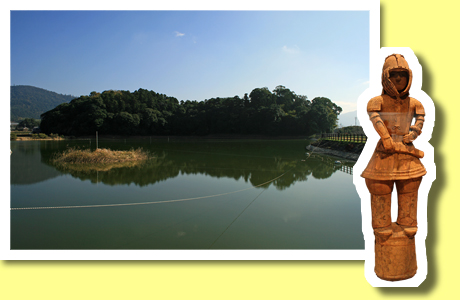
Yayoi Period was followed by Kofun Period ( 3rd - 6th century A.D. ), during which many Kofun ( burial mounds ) were constructed all over Japan except Hokkaido. Hashihaka Kofun ( above left ), Nara Prefecture, Kinki region is a burial mound constructed in the mid-3rd century. Some say that Hashihaka Kofun was a burial mound constructed for Himiko who ruled Yamatai kingdom.
Many Kofun mounds were surrounded by numbers of Haniwa ( ancient clay figures ), some of which show the shape of ancient warriors. The above-right shows Haniwa warrior, exhibited in Tokyo National Museum, Ueno, Tokyo.
During Kofun Period, Yamato state grew and unified most of Japan except Hokkaido, Northern Tohoku and Southern Kyushu. Kofun mounds were the symbol of the unification. It is believed that the rulers of Yamato state are ancestors of the Imperial House of Japan.
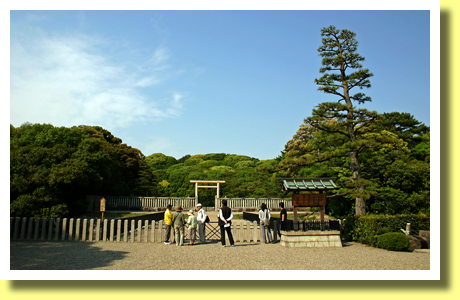
There were several types of Kofun constructed such as circular, square
and keyhole shaped. Most of large Kofun mounds were keyhole shaped, such as Daisenryo Kofun ( above ), Sakai City, Osaka Prefecture, Kinki region. Daisenryo, almost 500m long, is the largest Kofun and is too big to see its keyhole shape. Also it is one of some included in UNESCO World Heritage Site. They say that Daisenryo Kofun was a burial mound constructed for Emperor Nintoku.
|
Asuka Period
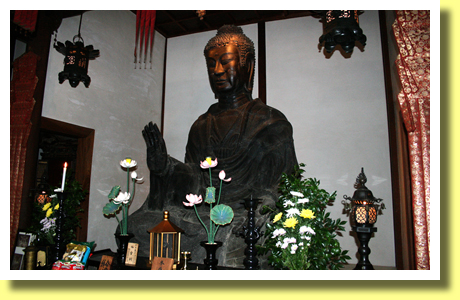
During Asuka Period ( the 6th century A.D. - A.D.710 ), while Asuka ( now Asuka Village located in Nara Prefecture, Kinki region ) was the political center of Japan, various reforms were carried out, such as Buddhism introduced in the 6th century. The oldest Buddha statue ( made in the early 7th century A.D. - above ) remains in Ango-in temple, which is located in the site of Asuka-dera Buddhism temple, which was founded in Asuka in the late 6th century.
Prince Shotoku, Regent, introduced the Seventeen-Article Constitution in A.D.604. In the letter sent to China in A.D.607, he described Japan as "the land of the rising sun", which later became the name of Japan "Nippon ( or Nihon )" meaning "a place where the sun rises".
In the mid-7th century A.D., Taika Reforms, modelled after Chinese govenmental systems, began to centralize political power. Ministries were organized. Taiho-Ritsuryo ( Taiho Legal Code ) was compiled. Regions were reorganized into 66 provinces. Land was nationalized, subdivided and allocated to farmers. Kogo-Nenjaku ( household registry ) was compiled. Taxation system was reformed.
|
Nara Period
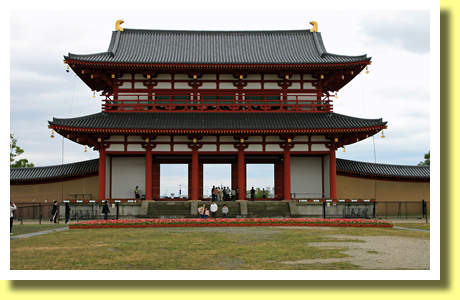
In A.D.710, Heijo-kyo ( now Nara City, Nara Pref., Kinki region ), the first permanent Japanese capital city modeled after the capital city of the Chinese Tang dynasty, was constructed and Nara Period ( A.D.710 - 794 ) started. Heijo-kyu ( Heijo Palace ), the Imperial residence was placed in the north of the new capital city. The Palace had twelve gates, among which the Suzaku Gate was the largest and the main entrance. The above photo shows the Suzaku Gate reconstructed in A.D.1998.
Heijo-kyo was the political and administrative center, where located were not only the Imperial Palace but also ceremonial structures and government ministries. The sites of Heijo-kyo and Heijo-kyu are included in a UNESCO World Heritage Site and one of designated Historic Monuments of Japan. Daigokuden, the most important building in the Palace was reconstructed in A.D.2010.
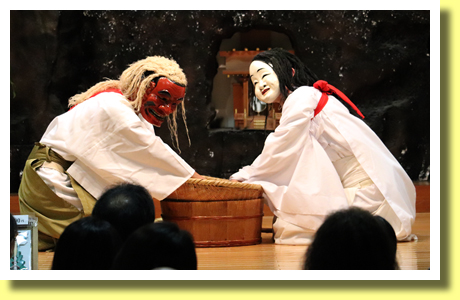
In A.D.712, Kojiki ( an Account of Ancient Japan ), was compiled. Kojiki includes the ancient myths regarding Gods and Goddesses. They say that some of the Gods and Goddesses are the ancestors of the Imperial Family. Some of Kagura ( Shinto Ritual Dance ) show episodes related to the Gods and Goddesses described in Kojiki. The above photo shows an Kagura episode performed in Takachiho Town, Miyazaki Prefecture, Kyushu region, related to Izanagi and Izanami, who are thought to be the ancestors of the Emperors.

Nara Period started when the new capital city was constructed. However lots of people suffered in the period. In the 8th century, there were droughts, famines, a rebellion and epidemics. The outbreaks of smallpox killed about 30 pct of the population. In A.D.752 Emperor Shomu, expecting the help of Buddha, constructed Todai-ji Temple where Daibutsu, a large bronze statue of Buddha ( above ) is housed.
Daibutsu has been damaged by an earthquake in A.D.855, by the fires of war in A.D.1180 and A.D.1567 and restored repeatedly. Now lots of tourists visit Todai-ji Temple in Nara City, Nara Prefecture to see Daibutsu ( 14.7 meters tall ). Todai-ji Temple and Daibutsu are a part of UNESCO World Heritage Site "Historic Monuments of Ancient Nara".
|
Heian Period
In A.D.794, the second permanent capital city, Heian-kyo ( now Kyoto City, Kyoto Prefecture, Kinki region ), was constructed after the model of the capital city of the Chinese Tang dynasty and Heian Period ( A.D.794 - A.D.1185 ) started. Heian-kyo had been the capital city until A.D.1868 even after samurai warriors established their shogunates.
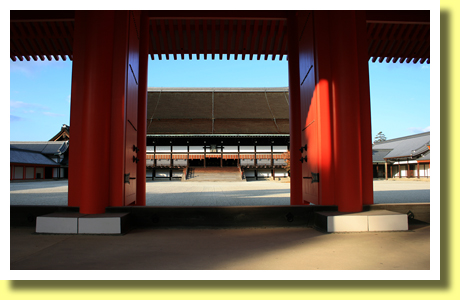
Daidairi, the Imperial Palace, was located in the north of Heian-kyo. The structures of the Imperial Palace were burnt down repeatedly and the buildings reconstructed in A.D.1855 remain in Kyoto City. The above photo shows Jomei-mon Gate and Shishinden of Kyoto Imperial Palace, where the enthronement ceremonies of Emperor Taisho and Emperor Showa were held.
Though Kyoto Imperial Palace is not open to the public, visitors could join guided tours under a certain conditions to walk around Kyoto Imperial Palace. Also visitors could join guided tours to visit Kyoto Sento Imperial Palace, Katsura Imperial Villa and Shugakuin Imperial Villa.
In the 9th century, the Fujiwara clan, a family of court nobles, baceme so powerful politically. They had their daughters married with Emperors and Crown Princes and the daughters of the Fujiwara clan bore Crown Princes. Also the clan owned lots of shoen ( tax exempt manors ) all over the country and accumulated economic resources while the Imperial Court declined economically as well as politically.

Michinaga Fujiwara, the head of the clan through the end of the 10th century - A.D.1028, dominated the court substantially. He had a villa, which was made a Buddhist temple, Byodo-in in A.D.1052 by his son, Yorimichi Michinaga. The above photo shows Phoenix Hall of Byodo-in Temple, which is one of designated National Treasures of Japan and a UNESCO World Heritage Sites.
In A.D.1068, Emperor Go-Sanjo was enthroned. His mother was not a daughter of The Fujiwara clan and Go-Sanjo was ready to rule by himself. So the Fujiwara clan became less influential politically. In A.D.1072, Emperor Go-sanjo abdicated and his son, Emperor Shirakawa was enthroned. However Go-sanjo remained substantial ruler. Since then on, retired emperors ruled behind their sons and/or their grandsons.
While the Fujiwara clan and other court nobles enjoyed prosperity and high art in Heian-kyo ( Kyoto ), many warriors fought to expand the territory of the government in Tohoku region. Such battles provided samurai warriors with opportunities to grow. Also power struggles inside the Imperial Family and Fujiwara clan made samurai warriors far more powerful.
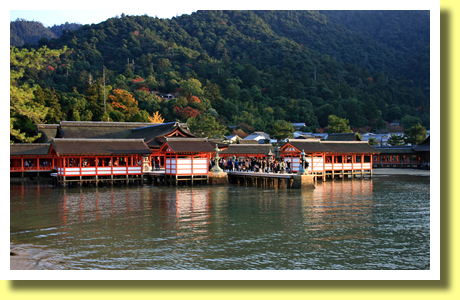
In the mid-12th century, Kiyomori Taira, the head of Taira clan and a leader of a samurai group, defeated a rival, the Minamoto clan and dominated the Imperial Court. In A.D.1168 Kiyomori Taira constructed the buildings of Itsuku-shima Jinja Shrine ( above ), which looks floating on the sea at the high tide. Itsuku-shima Jinja Shrine, located in Hatsukaichi City, Hiroshima Prefecture, Chugoku region, is one of designated National Treasures of Japan and a UNESCO World Heritage Sites.
|
Copyright (c) 2021 Achi-Kochi Zanmai Co., Ltd.
|